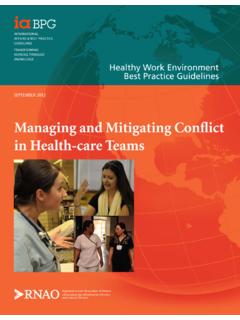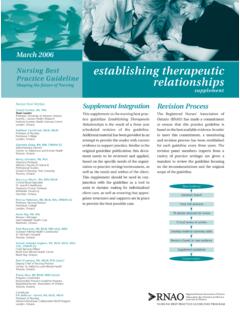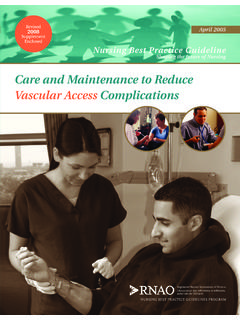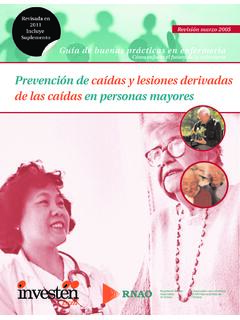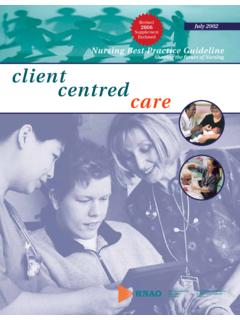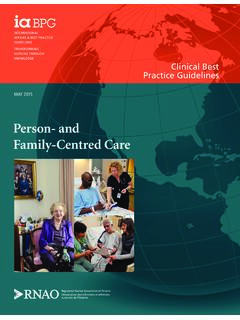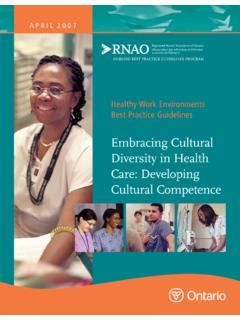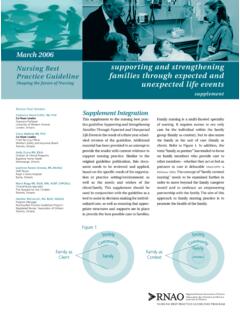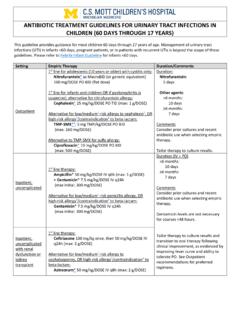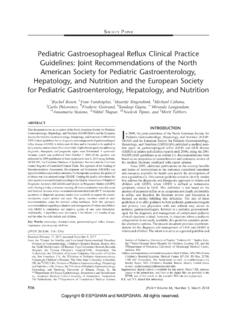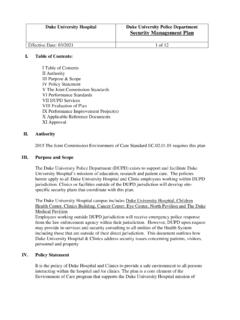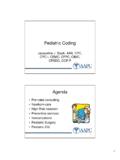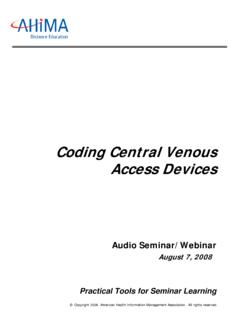Transcription of Ostomy Care Management - RNAO
1 Ostomy Care and Management BEST PRACTICE GUIDELINES 1 AUGUST 2009 Ostomy Care and ManagementClinical Best Practice GuidelinesOstomy Care and Management2 REGISTERED NURSES ASSOCIATION OF ONTARIOD isclaimerThese guidelines are not binding on nurses or the organizations that employ them. The use of these guidelines should be flexible based on individual needs and local circumstances. They neither constitute a liability nor discharge from liability. While every effort has been made to ensure the accuracy of the contents at the time of publication, neither the authors nor the Registered Nurses Association of Ontario (RNAO) give any guarantee as to the accuracy of the information contained in them nor accept any liability, with respect to loss, damage, injury or expense arising from any such errors or omission in the contents of this work.
2 CopyrightWith the exception of those portions of this document for which a specific prohibition or limitation against copying appears, the balance of this document may be produced, reproduced and published in its entirety, without modification, in any form, including in electronic form, for educational or non-commercial purposes. Should any adaptation of the material be required for any reason, RNAO written permission must be obtained. Appropriate credit or citation must appear on all copied materials as follows:Registered Nurses Association of Ontario.(2009) Ostomy Care and Management . Toronto, Canada. Registered Nurses Association of Ontario. This Program is funded by the Ministry of Health and Long-Term InformationRegistered Nurses Association of Ontario158 Pearl Street, Toronto, Ontario M5H 1L3 Website: Care and ManagementOstomy Care and ManagementGreetings from Doris Grinspun,Executive Director Registered Nurses Association of OntarioIt is with great excitement that the Registered Nurses Association of Ontario (RNAO) presents this guideline, Ostomy Care and Management , to the health care community.
3 Evidence-based practice supports the excellence in service that nurses are committed to delivering in our day-to-day practice. RNAO is delighted to provide this key resource to you. RNAO offers its heartfelt thanks to the many individuals and institutions that are making our vision for Nursing Best Practice Guidelines (BPGs) a reality: the Government of Ontario for recognizing our ability to lead the program and providing multi-year funding; Irmajean Bajnok, Director, RNAO International Affairs and Best Practice Guidelines (IABPG) Pro-grams, for her expertise and leadership in advancing the production of the BPGs; each and every Team Leader involved, and for this BPG in particular Kathryn Kozell for her superb stewardship, commitment and, above all, exquisite expertise. Also thanks to Rishma Nazarali, RNAO s IABPG Program Manager, for her intense work to see that this BPG moved from concept to reality.
4 A special thanks to the BPG Panel we respect and value your expertise and volunteer work. To all, we could not have done this without you!The nursing community, with its commitment and passion for excellence in nursing care, is providing the knowledge and countless hours essential to the development, implementation, evaluation and revision of each guideline. Employers have responded enthusiastically by nominating best practice champions, implementing and evaluating the guidelines and working towards a culture of evidence-based practice. Successful uptake of these guidelines requires a concerted effort from nurse clinicians and their health care colleagues from other disciplines, from nurse educators in academic and practice settings and from employers. After lodging these guidelines into their minds and hearts, knowledgeable and skill-ful nurses and nursing students need healthy and supportive work environments to help bring these guidelines to practice actions.
5 We ask that you share this guideline with members of the interdisciplinary team as there is much to learn from one another. Together, we can ensure that the public receives the best possible care every time they come in contact with us. Let s make them the real winners in this important effort!Doris Grinspun, RN, MScN, PhD(c), O. DirectorRegistered Nurses Association of Ontario BEST PRACTICE GUIDELINES 3 Ostomy Care and Management4 REGISTERED NURSES ASSOCIATION OF ONTARIOT able of ContentsHow to use this Document ..6 Purpose and Scope.. 7 Summary of Recommendations ..8 Interpretation of Evidence ..11 Development Panel Members ..12 Stakeholder Acknowledgement ..14 Background Context ..17 Core Recommendations ..19 Practice Recommendations ..26 Education Recommendations ..45 Organization & Policy Recommendations ..47 Research Gaps and Future Implications.
6 49 Evaluation/Monitoring of Guideline ..50 Implementation Strategies ..52 Process for Update/Review of Guideline ..53 Reference List ..54 Bibliography ..60 BACKGROUNDRECOMMENDATIONSREFERENCESO stomy Care and ManagementOstomy Care and Management BEST PRACTICE GUIDELINES 5 APPENDICESA ppendix A: Glossary of Terms ..64 Appendix B: Glossary of Clinical Terms ..65 Appendix C: Guideline Development Process .. 73 Appendix D: Process for Systematic Review/Search Strategy ..74 Appendix E: Sample Ostomy Teaching Record .. 77 Appendix F: Sexuality Information ..80 Appendix G: Sample Assessment Form .. 81 Appendix H: Medication and Ostomy Function ..84 Appendix I: Nutritional Management Tips in Ostomy Care ..88 Appendix J: Ostomy Teaching Flow Sheets ..92 Appendix K: Ontario Chapter, United Ostomy Association of Canada ..97 Appendix L: Resource Information.
7 98 Appendix M: Ostomy Care Form ..102 Appendix N: Special Needs and Care Strategies ..103 Appendix O: Ostomy Product List ..104 Appendix P: Recommended Ostomy Educational Program Content for Health-Care Providers ..106 Appendix Q: Erikson s Developmental Stages ..111 Appendix R: Recognized Educational Programs ..112 Appendix S: Charter of Ostomates Rights ..113 Appendix T: Description of the Toolkit ..114 BACKGROUNDO stomy Care and Management6 REGISTERED NURSES ASSOCIATION OF ONTARIOHow to Use this DocumentThis nursing best practice guideline is a comprehensive document providing resources necessary for the support of evidence based nursing practice. The document needs to be reviewed and applied, based on the specific needs of the organization or practice setting/environment, as well as the needs and wishes of the client. Guidelines should not be applied in a cookbook fashion but used as a tool to assist in decision making for individualized client care, as well as ensuring that appropriate structures and supports are in place to provide the best possible , other health care professionals and administrators who are leading and facilitating practice changes will find this document valuable for the development of policies, procedures, protocols, educational programs, assessment and documentation tools, etc.
8 It is recommended that the nursing best practice guidelines be used as a resource tool. Nurses providing direct client care will benefit from reviewing the recommendations, the evidence in support of the recommendations and the process that was used to develop the guidelines. However, it is highly recommended that practice settings/environments adapt these guidelines in formats that would be user-friendly for daily use. This guideline has some suggested formats for such local adaptation and wishing to use the guideline may decide to do so in a number of ways: a) Assess current nursing and health care practices using the recommendations in the guideline. b) Identify recommendations that will address identified needs or gaps in services. c) Systematically develop a plan to implement the recommendations using associated tools and RNAO is interested in hearing how you have implemented this guideline.
9 Please contact us to share your story. Implementation resources will be made available through the RNAO website to assist individuals and organizations to implement best practice Care and ManagementBACKGROUNDO stomy Care and ManagementPurpose and ScopeBest practice guidelines are systematically developed statements to assist practitioners and clients decisions about appropriate health care (Field & Lohr, 1990). This guideline provides evidence-based recommendations for Registered Nurses and Registered Practical Nurses related to the assessment and Management of people with colostomies, ileostomies and urostomies, including the assessment and Management of the peristomal guideline will focus on three areas of care: pre-operative, post-operative, and follow-up. All indi-viduals with ostomies, across the continuum of care, including the needs of the family and caregiver, will be is intended that this guideline will be applicable to all domains of nursing including clinical, ad-ministration and education.
10 BEST PRACTICE GUIDELINES 7 BACKGROUNDO stomy Care and Management8 REGISTERED NURSES ASSOCIATION OF ONTARIO8 REGISTERED NURSES ASSOCIATION OF ONTARIO1 Develop a therapeutic relationship with the client and family. III2 Perform a comprehensive assessment of the client/family that includes: a) history and physical; b) psychosocial (coping and adaptation, altered body image, impaired quality of life, sexuality and sexual concerns); and c) cultural, spiritual and religious norms. III3 Consult with interdisciplinary team members for assessment and intervention as needed for all clients requiring, or who already have, an Ostomy . IV4 Design a mutually acceptable plan of care between the client/family and all health-care providers, which optimizes health and self-efficacy in Ostomy Management . IIIS ummary of Recommendations Core RecommendationsRECOMMENDATION*Level of Evidence5 Pre-operative education should be provided to all clients and families requiring Ostomy surgery.
